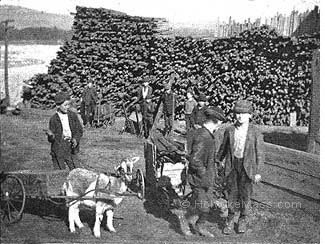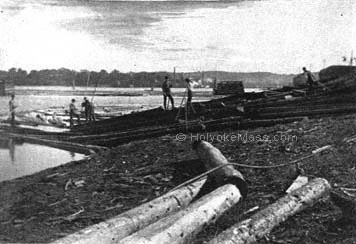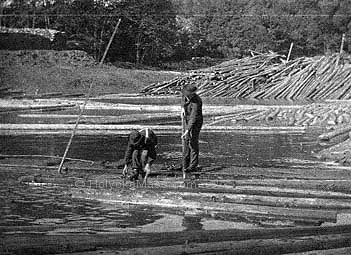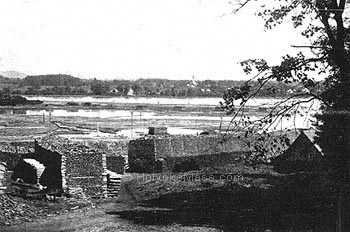
Millyard Trams.
|
Connected with this district is a famous ghost story, which runs as follows: In the old days there lived on Back street a Mr. Felt. One fall he sowed a field to rye, which in the spring looked green and thrifty, and he was much disturbed at the frequent visits of neighbor Hummerston’s geese to the said field. Mr. Felt had a quick temper, and this sort of thing was too much for him. He caught the whole flock one day, killed them, and then wended his way to Deacon Hummerston to inform him what he had done and where his geese were to be found. This and other acts, showing his hasty temper and savage disposition, brought Mr. Felt into disrepute among his neighbors. He often cruelly beat his horses and cattle, and there were times when he served the members of his family in the same way. He had a son, Timothy by name, a dull-witted fellow, who was slow of comprehension and in his work made many mistakes. This was a frequent cause of anger to the father, who on such occasions would strike Tim to the earth with whatever implement he happened to have in hand--a hoe, a rake, or a pitchfork, perchance. These attacks sometimes drove Tim from home, but after a few days’ absence necessity would bring him back again. At last, however, he disappeared and was seen no more, and a little later the Felts moved west. In building the New Haven and Northampton canal, a great deal of limestone was used. On Mr. Felt’s farm was a ledge of this rock, and the company soon had a quarry there. The overseer was a rough, ill-tempered fellow, and it was not long before he had trouble with his workmen and they all left him. That brought work to a standstill, and the overseer was at his wits’ end to find some way out of the difficulty. One night, shortly after the men left, the overseer, on his way home from the corner store, quite late, saw a dark figure standing on the ledge outlined against the sky. The overseer stood still, his frightened gaze riveted on the stranger. Presently he broke the silence by asking, "Who are you and what is your business?" The specter replied, "My name is Timothy Felt, and my bones are under where I now stand. I was killed by my father four years ago, and if you will blast this rock you will find my bones." This story ran through all the county round and created great excitement. Every day for some time thereafter, loads of people, not only from Ireland Parish but from towns quite distant, wended their way thither, inquiring the way to the "ghost place," and when night came on people would make a long detour rather than pass the place. Money was raised to continue the quarrying until Tim’s skeleton should be brought to light, but no bones were found, and after the overseer had gotten out what stone he wanted, the work lagged and was discontinued. Was this humbug or not? One good lady used to say:
"Where folks believe in witches, witches are,
But when they don’t believe, there are none there."

Along Shore.
|
In this case there was wide belief that Tim was murdered, and that his ghost really did appear.
From Back street it is only a short ways to Ashley ponds, Holyoke’s chief source of water supply. You catch glimpses of the gleaming water from the crests of the rolling hills as you approach, and the look across the ponds on a bright afternoon, as they shine in the sunlight and link away into the distance, is very pleasing.
On the road back to the city we pass through Elmwood, a populous suburban village on high ground, well above the mills of the city and the lower valley. Many well-build cottages and fine mansions here congregate and make scattering connections with the city to the north. On the borders of the village is an interesting old burying ground, overlooking the leagues and leagues of fertile valley spreading away to the south and enlivened here and there with bright reaches of the Connecticut. The gray, moss-grown old stones seem like a part of nature, so quiet and harmonious is their coloring, and they give to eye and mind a soothing sense of fitness which the white marbles of today entirely lack.
Farther down the valley is the prettily named district of Ingleside. It is a strip of meadow land along the river, rising a little way back into low lines of hills, where are many clustering fields of apple orchards. It is a beautiful region at any season, but is especially so in blossom time, when the orchards are mists of white petals and the fresh green of the grass fields is everywhere broken with the golden flecks of the dandelions and buttercups. The lowland here is a famous region for market gardening, and several large dairy farms have here a home. The road in the valley is more than ordinarily smooth and well kept, and is, therefore, a favorite resort for driving and bicycling, both of Holyoke and Springfield people. Evenings, in particular, there is a busy passing of every variety of four-wheeled vehicle, and an almost continual flitting of cyclers. The pleasantest evenings are those when the moon shines full above the low hills in the east and floods all the landscape with its soft light.

Logmen at Work.
|

The River and Shores at the Sawmills.
|
© Laurel O’Donnell 1996 - 2006, all rights reserved
This document may be downloaded for personal non-commercial use only
and may not be reproduced or distributed without permission in any format.
This is an edited adaptation from the original publication.
|